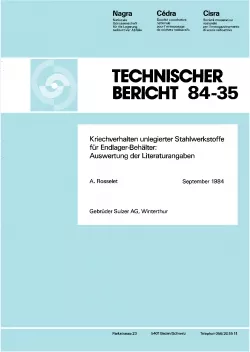
Technischer Bericht NTB 84-35
Kriechverhalten unlegierter Stahlwerkstoffe für Endlager-Behälter:Auswertung der Literaturangaben
The Nagra concept for final disposal of high level waste foresees that the vitrified waste will be enclosed in corrosion resistant containers before placement in the repository. According to the safety concept, the principal function of the containers is to prevent contact between the groundwater and the waste for a given time (1000 years), i.e. to delay the release of the content for this length of time. As a part of the mechanical properties evaluation program of the candidate materials for the containers, a review of the available literature on creep behaviour of carbon steels has been undertaken.
Due to the shortage of usable information, it is not possible to forecast exactly the amount of creep deformation in carbon steels over 1000 years at temperatures up to 140°C. However, the following conclusions can be drawn:
At room temperature below the yield stress, no creep has been observed. An extrapolation of the available data to the design temperature of 140°C is not possible. The same is true for the data available for temperatures above 300°C. The reason is that the variation of the activation energy for creep (which characterizes the creep resistance of the material) with temperature is not known. The small amount of data for the temperature range 100 to 300°C can be used to estimate a creep deformation at 140°C for 1000 years of below 1 %. It is also probable that the amount of deformation will depend more on the mechanical properties of the material (yield and ultimate strengths) than on the material itself (steel, cast steel, nodular iron). The possibility that the creep rate will be influenced by effects such as hydrogen diffusion or radiation cannot be excluded, as these points are scarcely documented. Consequently, an experimental determination of the creep behaviour of the chosen material is recommended, if a creep strain of 1 % or less cannot be tolerated. In this case, the influence of hydrogen diffusion and radiation should be also investigated.
